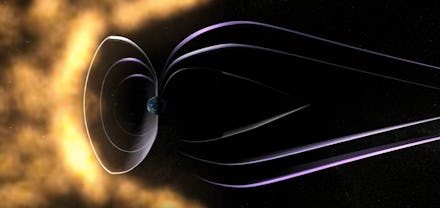NASA Just Witnessed One of Space's Biggest Mysteries — Here's What It Found

A NASA spacecraft just got a front-row seat to witness one of nature's most mysterious processes.
For the first time ever, NASA flew a spacecraft directly through a "maelstrom" that scientists refer to as a magnetic reconnection. Magnetic reconnection happens when two magnetic fields bump into each other and then realign:
Magnetic fields are spread out all over space. They're responsible for much of the dangerous radiation that our satellites and astronauts have to fly through.
Understanding how magnetic reconnection works is critical to figuring out how to protect future spacecraft and astronauts from radiation.
When magnetic fields bump into each other, they sometimes trigger a huge explosion that flings particles away at nearly the speed of light, before the fields realign. But scientists aren't sure why this explosive behavior only happens some of the time.
"One of the mysteries of magnetic reconnection is why it's explosive in some cases, steady in others, and in some cases, magnetic reconnection doesn't occur at all," Tom Moore, a NASA researcher, said in a statement.
NASA flew a constellation of four satellites, called the Magnetic Multiscale Mission (MMS), straight through one of these magnetic reconnections that happened when Earth's magnetic fields bumped into the sun's magnetic fields.
MMS passed right through the center of the collision:
The satellites were able to track how the magnetic fields shifted and what path the ejected particles took. This is what the collision looked like on the satellites' sensors:
The particles shot out in a straight line at hundreds of miles per second, but once they encountered a new magnetic field, they made a sharp U-turn and returned the collision site. The data actually lines up nicely with computer models that predicted similar behavior.
"The data showed the entire process of magnetic reconnection to be fairly orderly and elegant," NASA scientist Michael Hesse said in a statement. "There doesn't seem to be much turbulence present, or at least not enough to disrupt or complicate the process."
Scientists have data from five more magnetic reconnection events, so we should know more about this explosive process soon.